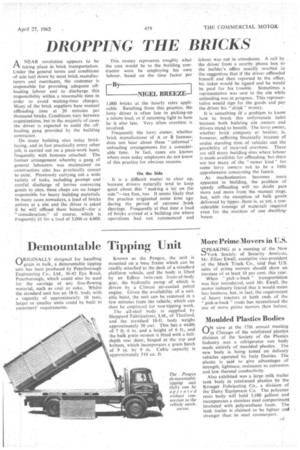DROPPING THE BRICKS
Page 51

If you've noticed an error in this article please click here to report it so we can fix it.
By NIGEL BREEZE-I
rAA NEAR revolution appears to be taking place in brick transportation. Under the general terms and conditions of sale laid down by most brick manufacturers and merchants, the customer is responsible for providing adequate offloading labour and to discharge this responsibility within a reasonable time in order to avoid waiting-time charges. Many of the brick suppliers base manual offloading time at 20 minutes per thousand bricks. Conditions vary between organizations, but in the majority of cases the driver is expected to assist the offloading gang provided by the building contractor.
On many building sites today bricklaying, and in fact practically every other job, is carried out on a piece-work basis, frequently with bonuses attached. The former arrangement whereby a gang of general labourers was maintained on construction sites has practically ceased to exist. Previously carrying out a wide variety of tasks, including prompt and careful discharge of lorries conveying goods to sites, these chaps are no longer responsible for heavy building materials. In many cases nowadays, a load of bricks arrives at a site and the driver is asked if he will offload them himself—for a " consideration," of course, which is frequentlY £1 for a load of 3,000 or 4,000.
This money represents roughly what the cost would be to the building con.tractor were he employing his own labour, based on the time factor per 1,000 bricks at the hourly rates applicable. Resulting from this practice, the lorry driver is often late in picking-up a return load, or if returning light to base he is also late. Very often overtime is involved.
Frequently the lorry owner, whether brick manufacturer of A or B licensee, does not hear about these "informal" unloading arrangements for a considerable time. In fact, cases are known where even today employers do not know of this practice for obvious reasons.
On the Side It is a difficult matter to clear up, because drivers naturally tend to keep quiet about this "making a bit on the side "—tax free, too. It seems likely that the practice originated some time ago during the period of extreme brick shortage. Frequently at that time a load of bricks arrived at a building site where operations had not commenced and labour was not in attendance. A call by the driver from a nearby phone box to the builder's office usually resulted in the suggestion that if the driver offloaded himself and then reported to the office, his ticket would be signed and he would be paid for his trouble. Sometimes a representative was sent to the site while unloading was in progress. This representative would sign for the goods and pay the driver his " drink " money.
It is something Of a problem to know how to break this unfortunate habit because both building site owners and drivers stand to benefit. The lorry owner, whether brick company or haulier, is, however, suffering financially because of undue standing time of vehicles and the possibility of incurred overtime. There are still many building sites where labour is made available for offloading, but there are too many of the " newer kind for some lorry owners not to be a little apprehensive concerning the future.
As mechanization becomes more apparent in building, the problem of speedy offloading will no doubt pass more and more from the manual stage, but, with the exception of bulk goods delivered by tipper, there is, as yet, a considerable tonnage of materials required even for the erection of one dwellinghouse.




















































































































